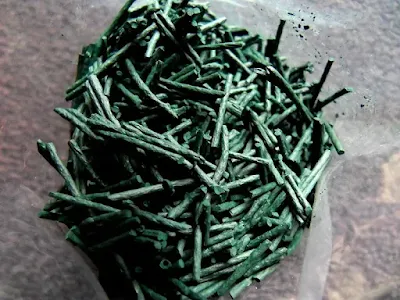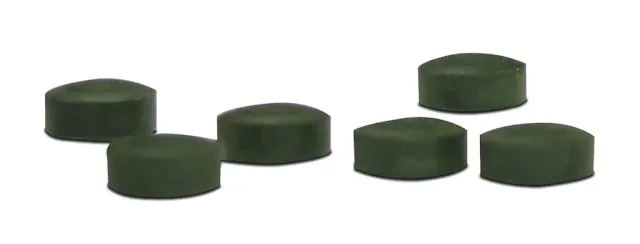What is Spirulina?
 |
Credits
to WILLPOWER STUDIOS |
 |
| Aztec Empire - ru.svg: Kaidorderivative work: Rowanwindwhistler, CC BY-SA 4.0, via Wikimedia Commons |
This supplement - Spirulina is a microscopic and thread-like
structured cyanobacterium known for its spiral or helical filaments. In short,
it is a type of blue-green algae. With a historical usage dating back to the
Aztec civilization (Aztec Empire was a combination empire of three states in
around 1450s including Mexico, Texcoco,
and Tlacopan) , it refers to the dried biomass of Arthrospira platensis — a globally
distributed oxygenic photosynthetic bacterium blooming in both fresh and marine
waters. This alga has served as a significant dietary supplement for humans,
providing a good source of protein and many essential vitamins, including B12
and provitamin A (β-carotenes), along with minerals such as iron. There is many
more to be told that will be explained in below sections.
They are two major types of Spirulina that are consumed in the world and they are :
 |
| Siongthong, CC BY-SA 4.0, via Wikimedia Commons |
Well, matter of fact they both are green. But there is one variant of Spirulina that is Blue in colour. Now, you might get amazed because of its colour and ask me “What Is Blue Spirulina ?”. Here is your answer, it is actually derived from the Green Spirulina itself. The differences that this Blue Spirulina has over Green Spirulina is that its colour obviously and its more concentrated amount of an antioxidant known as phycocyanin (It is an antioxidant, which means it helps protect our body cells from damage). Not to forget its much milder taste as the green one is so called earthy taste while the blue is much milder.
Where does it grow?
 |
| Lamiot, CC BY-SA 3.0, via Wikimedia Commons |
Spirulina is found in many locations around the world. It prefers to grows in warm places (as any other algae and fungi), alkaline waters such as freshwater lakes, ponds, and rivers. Spirulina is known to grow in tropical and subtropical regions where the temperatures are typically high. Some specific geographic locations where Spirulina is commonly cultivated include:
- Africa: Countries like Chad
are known for natural occurrences of Spirulina in lakes such as Lake Chad.
- Asia: Spirulina is
cultivated in countries like India, Thailand, and China, where it has been used
as a food source.
- Central and South
America: Mexico is one of the countries where Spirulina has historical use,
dating back to the Aztec civilization. Spirulina maxima, cultivated in Mexico,
is one of the popular varieties.
- North America: Spirulina is also
cultivated in California, USA. Spirulina platensis, cultivated in California,
is among the most popular varieties.
- Hawaii: Spirulina is
cultivated in controlled environments, such as ponds and tanks in places like
Hawaii.
Additionally, cultivation can also take place in artificial environments like specialized ponds, tanks, and controlled environments where conditions can be optimized for its growth.
What is spirulina good for?
You will also have a question why would I even buy it when I don’t even now its benefits. Well, consuming Spirulina offers several benefits for the human body, including:
- Rich in
Nutritional Content:
Spirulina is a nutrient-dense superfood,
providing essential proteins, vitamins (including B12 and provitamin A), and
minerals (such as iron), supporting overall health and well-being.
- Antioxidant
Properties: Spirulina contains antioxidants, particularly phycocyanin,
which can help protect cells from oxidative stress and reduce free radical
damage.
- Anti-Inflammatory
Effects: Some studies and researches suggest that Spirulina has anti-inflammatory
properties, helping to alleviate inflammation in the body.
- Immune System
Support: The nutrients in Spirulina contribute to a strengthened
immune system, promoting better resistance against infections and illnesses.
- Lipid-Lowering
Effects: Spirulina contribute to reducing total cholesterol and
triglyceride levels, supporting cardiovascular health.
- Blood Pressure
Regulation: Some research indicates that Spirulina may have a positive
impact on blood pressure regulation.
- Allergy Relief: Spirulina has
been explored for its ability to alleviate symptoms of allergic rhinitis and
reduce histamine levels, providing relief for some allergy sufferers.
- Helps in Detoxification: Spirulina assists
in the detoxification process by helping to eliminate heavy metals from the
body.
What are the nutritional values of spirulina?
Below is the table giving detailed composition of
nutritional values of 100g dried spirulina :
| Nutrient | Value |
|---|---|
| Calories | 290 |
| Protein | 57.5g |
| Total Fat | 7.7g |
| Saturated Fat | 2.65g |
| Monounsaturated Fat | 0.675g |
| Polyunsaturated Fat | 2.08g |
| Carbohydrates | 23.9g |
| Dietary Fiber | 3.6g |
| Sugars | 1.7g |
| Vitamins and minerals (approximate values): | |
| Vitamin B1 (Thiamine) | 2.38 milligrams |
| Vitamin B2 (Riboflavin) | 3.67 milligrams |
| Vitamin B3 (Niacin) | 12.82 milligrams |
| Vitamin B6 (Pyridoxine) | 0.364 milligrams |
| Vitamin B9 (Folate) | 94 micrograms |
| Vitamin C | 10.1 milligrams |
| Vitamin E | 5 milligrams |
| Vitamin K | 25.5 micrograms |
| Iron | 28.5 milligrams |
| Copper | 0.6 milligrams |
| Manganese | 3.55 milligrams |
| Magnesium | 195 milligrams |
| Potassium | 1363 milligrams |
If you consumed 100g of dried Spirulina, you could get up to 60g of protein ,290 calories and 20% of your daily required nutrition would get completed. Also, you could get 200% of your daily intake of Vitamin B1(Thiamine), Vitamin B2(Riboflavin) and Iron. Eventually, you will also complete your 90% daily requirement of Manganese. Additionally, DHA, EPA and Omega-3 Fatty acids are also present which makes it a good anti-oxidant and a good source of these three. Actually, spirulina doesn’t contain the true Vitamin B12. What I mean is that Vitamin B12 which is present here is Pseudo-Vitamin B12 which is not quite active in human body. This might cause problems if your vegan and you might not be able to complete your daily requirement of Vitamin B12 and thus get a deficiency of Vitamin B12.
How to use spirulina powder and What should be its dosage?
 |
| Music4thekids, CC BY-SA 3.0, via Wikimedia Commons |
Spirulina generally comes in the form of pills (tablets) and powder, which can be taken orally by us. Doctors recommended dosage of Spirulina is 19 grams per day for 2 months or you can even take 10 grams of Spirulina per day for 6 months straight. Some doctors may also recommend some other dosages, too.
Alternatives of Spirulina
Well, price-wise if we see spirulina is 30 times more expensive than most protein products like milk, meat and eggs. I know that it contains of 60% of protein but its too expensive. Meanwhile products like milk, meat , eggs and protein powder can easy cover your daily protein requirements.
Spirulina Side Effects
While Spirulina is generally considered safe for most people when consumed in recommended amounts, some individuals may experience side effects. It's important to be aware of these known side effects:
- Allergic
Reactions: Some people may be allergic to Spirulina. Allergic reactions
can range from mild symptoms like itching and hives to more severe reactions
such as difficulty breathing. If you're allergic to seafood, you might have a
higher risk of being allergic to Spirulina, as they share similar proteins.
- Gastrointestinal
Issues: Digestive discomfort, including nausea, vomiting, diarrhoea,
or abdominal pain, can occur in some individuals. Starting with a low dose and
gradually increasing it may help minimize these effects.
- Risk of
Contaminants: If Spirulina is contaminated during cultivation or
processing, it may contain harmful substances such as microcystins, which are
toxins produced by certain types of cyanobacteria. Choosing a reputable source
and ensuring the product undergoes quality testing can help mitigate this risk.
- Iodine
Sensitivity: Spirulina can absorb iodine from its environment, and
excessive iodine intake can be a concern for individuals with iodine
sensitivity or thyroid disorders.
- Interaction with
Medications: Spirulina may interact with certain medications, such as
immunosuppressants or anticoagulants. Not to forget its interaction with herbs.
Thus, it's advisable to consult with a healthcare professional, especially if
you are taking medications regularly.
- Risk of Heavy
Metal Accumulation: Spirulina can absorb heavy metals from its
growing environment. While reputable Spirulina producers test for heavy metal
content, it's important to choose products from reliable sources. If by any
chance the consumed Spirulina is contaminated, they it may show you the
following heavy side-effects like heavy liver damage, Stomach-ache, rapid heartbeats
and shock deaths.
- Deficiency of Vitamin
B12: Spirulina contains a form of Vitamin B12 called pseudo
vitamin B12, which is not effective in humans. Relying solely on Spirulina as a
B12 source may lead to a deficiency in true Vitamin B12.
Thus, taking advice from a doctor or physician before taking spirulina becomes mandatory here.
Who should one not take spirulina before consulting experts?
The issue here is not spirulina because it has been confirmed by NASA itself that spirulina is safe to be consumed. The issue is what type of spirulina you would consume? Spirulina which is not cultivated by recommended method or if one consumes naturally grown spirulina which may have contaminants like heavy metal, the recently trended brain eating amoeba which generally grows in swamps and places with still water, many viruses and bacteria. That leads to heavy damage to human as said earlier, like heavy liver damage and deaths. Thus, you should at least get consulted by an expert first and then take pills, tablets and powder from any reputed pharmaceutical company only.
Conclusion
In conclusion, Spirulina has gained popularity as a dietary supplement, with its rich nutritional content and potential health benefits. This microscopic cyanobacterium, dating back to the Aztec civilization, offers a complete protein source and essential vitamins and minerals. Two major types, Spirulina Maxima and Spirulina Platensis, are commonly consumed worldwide, with a notable variant, Blue Spirulina, distinguished by its colour and higher phycocyanin concentration. Spirulina is cultivated in various regions globally, including Africa, Asia, Central and South America, North America, and Hawaii. Its benefits range from immune system support to beneficial anti-inflammatory effects, making it a valuable addition to a healthy diet. However, caution should be exercised, considering possible side effects, such as allergies, gastrointestinal issues, and interactions with medications. Additionally, Spirulina's pseudo Vitamin B12 content may pose a challenge for vegans, necessitating careful consideration of dietary needs. Before adding Spirulina into one's routine, consulting a healthcare professional is advisable to ensure safe and effective use. Spirulina's high cost compared to other protein sources prompts consideration of alternatives for those with budget constraints. Lastly, I emphasize the importance of consulting experts, particularly for those at risk of contamination-related issues, ensuring the safe and informed consumption of Spirulina.
References : Here, I am giving credits to the websites which I took and shared all this precious information from. Also, the above information is been collected from many research papers and from various experts making it verified and correct. I would recommend you all to visit their sites and surf them for deeper information and knowledge :- Karkos PD, Leong SC, Karkos CD, Sivaji N, Assimakopoulos DA. Spirulina in clinical practice: evidence-based human applications. Evid Based Complement Alternat Med. 2011;2011:531053. doi: 10.1093/ecam/nen058. Epub 2010 Oct 19. PMID: 18955364; PMCID: PMC3136577.
- Wikipedia contributors. (2024c, January 30). Spirulina (dietary supplement) Wikipedia.https://en.wikipedia.org/wiki/Spirulina_(dietary_supplement)
